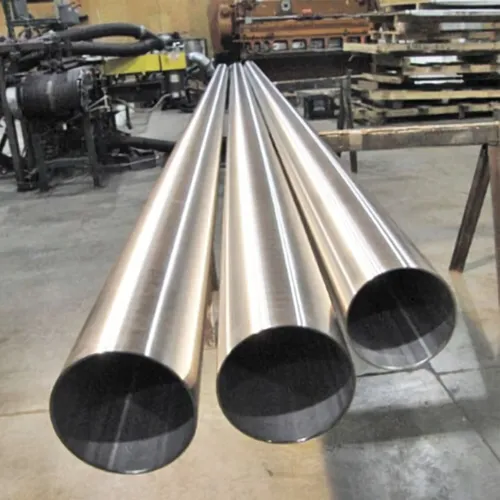
Titanium Pipes
An Introduction to High-Performance Titanium Pipes
Titanium pipes are specialized conduits designed for transporting fluids and gases in demanding industrial environments. Their primary role is conveyance, and they are defined by a nominal pipe size (NPS) and schedule (wall thickness) which determines their flow capacity and pressure rating.
The unparalleled corrosion resistance of titanium makes it the superior choice for systems handling aggressive media like saltwater, acids, chlorides, and other industrial chemicals. Unlike materials that degrade over time, titanium pipes offer an exceptionally long service life with minimal maintenance, ensuring system integrity and operational safety. Whether seamless for high-pressure applications or welded for large-diameter systems, titanium pipes provide a robust and reliable solution for the most critical fluid transport challenges.
Available Dimensions & Specifications
We offer both seamless and welded titanium pipes manufactured to strict international standards to ensure reliability and performance.
- Manufacturing Types:
- Seamless Pipe: Manufactured to ASTM B861. Ideal for high-pressure and high-temperature applications.
- Welded Pipe: Manufactured to ASTM B862. A cost-effective solution for large-diameter, low-to-medium pressure systems.
- Nominal Pipe Size (NPS): 1/2” to 24”
- Wall Thickness (Schedule): Sch 5S, Sch 10S, Sch 40S, Sch 80S, and heavier schedules available.
- Length: Standard 6-meter lengths or custom-cut as required.
Common Titanium Pipe Grades
The choice of grade is critical and depends on the fluid composition, temperature, and pressure of the application.
| Grade | Common Name(s) | Key Characteristics & Features | Typical Pipe Applications |
|---|---|---|---|
| Grade 2 | CP Ti Grade 2 | The industry standard for pipes. Excellent resistance to oxidizing and mildly reducing media. Good strength and weldability. | Chemical processing, desalination plants, power plant cooling systems, pulp & paper manufacturing. |
| Grade 7 | Ti-0.2Pd | The most corrosion-resistant titanium alloy. Superior resistance to reducing acids and localized crevice corrosion. | Transporting highly corrosive fluids like wet chlorine gas, nitric acid, and metallic chlorides. |
| Grade 12 | Ti-0.3Mo-0.8Ni | Offers enhanced strength at high temperatures and excellent resistance to crevice corrosion in hot brine and acidic solutions. | High-temperature chemical processing, sour gas applications, and specialized heat exchangers. |
| Grade 5 | Ti-6Al-4V | High-strength alloy. Used where pressure ratings are the primary concern, exceeding the capabilities of CP grades. | High-pressure hydraulic systems, subsea oil & gas lines, and specialized aerospace fluid transport. |
Example Applications of Titanium Pipes
Titanium pipes are essential for ensuring the safe and efficient operation of systems that handle corrosive fluids.
Chemical Processing Industry
- Process Piping: Used to safely transport acids, alkalis, and other corrosive chemicals between reactors, tanks, and processing units.
- Chlor-Alkali Production: The standard material for handling wet chlorine gas and sodium hypochlorite solutions where other metals fail rapidly.
Oil & Gas (Offshore & Onshore)
- Riser and Flowline Pipes: Its immunity to seawater corrosion and resistance to sour gas (H₂S) make it ideal for offshore platforms.
- Process Water Systems: Used for firewater systems and cooling loops on offshore rigs, providing a maintenance-free, long-term solution.
Power Generation
- Cooling Water Systems: Extensively used in coastal power plants (nuclear and fossil fuel) for condenser systems and cooling loops that use seawater or brackish water.
- Flue Gas Desulfurization (FGD): Resists the corrosive slurry and acidic condensates found in pollution control systems.
Desalination & Water Treatment
- Brine Transfer and Seawater Intake: The primary material for piping in desalination plants (MSF, MED, and RO) due to its complete resistance to hot, concentrated saltwater.
- High-Pressure Piping: Used on the high-pressure side of Reverse Osmosis (RO) systems.
Quick Contact
Related Products
Product Categories
- Titanium Anode Basket 1
- Titanium Foils 1
- Titanium Pipes 1
- Titanium Rods 1
- Titanium Tubes 1
- Titanium Wires 3
- Nuts & Bolts 1
- Special Titanium Alloys 1
- Titanium Anodes & Electrodes 1
- Titanium Equipment 1
- Titanium Mesh 1
- Titanium Sheets & Plates 1
- Titanium rods 3
- Titanium foils 3
- Titanium sheets and plates 3
- Titanium pipes 3